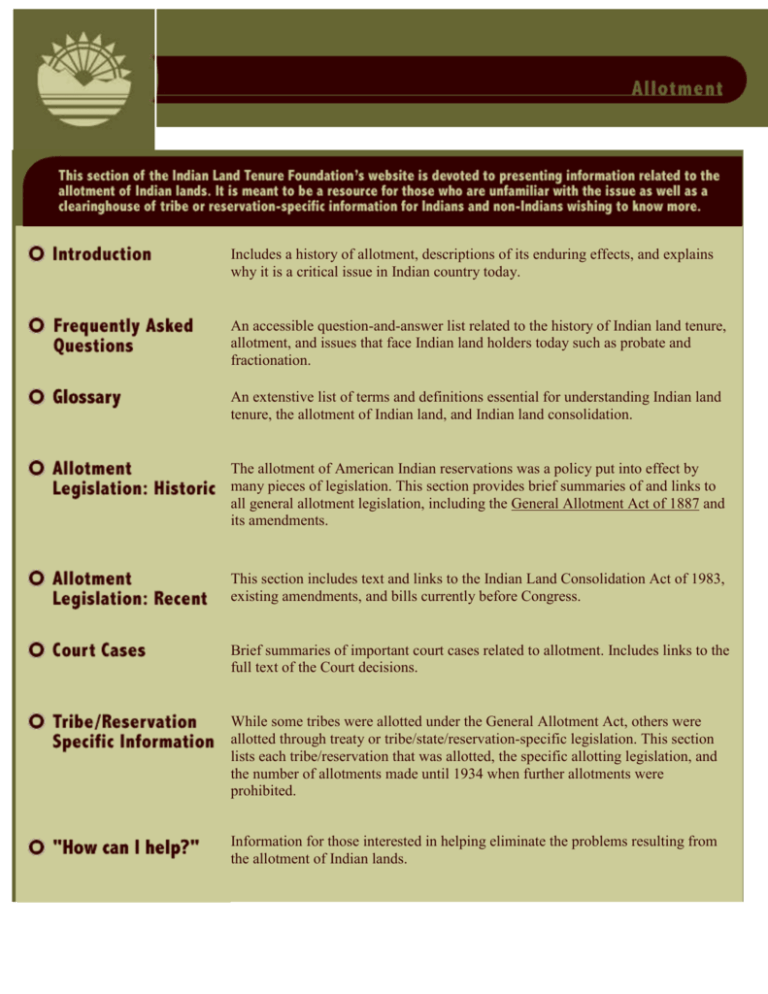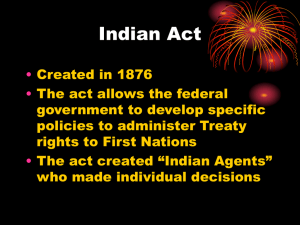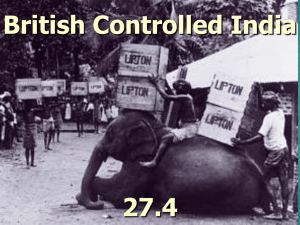
Includes a history of allotment, descriptions of its enduring effects, and explains
why it is a critical issue in Indian country today.
An accessible question-and-answer list related to the history of Indian land tenure,
allotment, and issues that face Indian land holders today such as probate and
fractionation.
An extenstive list of terms and definitions essential for understanding Indian land
tenure, the allotment of Indian land, and Indian land consolidation.
The allotment of American Indian reservations was a policy put into effect by
many pieces of legislation. This section provides brief summaries of and links to
all general allotment legislation, including the General Allotment Act of 1887 and
its amendments.
This section includes text and links to the Indian Land Consolidation Act of 1983,
existing amendments, and bills currently before Congress.
Brief summaries of important court cases related to allotment. Includes links to the
full text of the Court decisions.
While some tribes were allotted under the General Allotment Act, others were
allotted through treaty or tribe/state/reservation-specific legislation. This section
lists each tribe/reservation that was allotted, the specific allotting legislation, and
the number of allotments made until 1934 when further allotments were
prohibited.
Information for those interested in helping eliminate the problems resulting from
the allotment of Indian lands.
Summary of Act of April 30, 1934 (48 Stat. 647)
Another amendment to section 1 of the Act of June 25, 1910, relating to the powers
of the Secretary of the Interior to determine the heirs of deceased Indians and the
disposition or sale of allotments.
Click here for full text in Kappler’s Indian Affairs: Laws and Treaties, produced by
Oklahoma State University Library.
.
Summary of Act of June 18, 1934 (48 Stat. 984) Also known as the HowardWheeler Act or Indian Reorganization Act
Section 1: Prohibits further allotment of Indian lands on or after June 18, 1934.
Section 2: Extends, until otherwise directed by Congress, existing periods of trust
and restrictions on alienation placed on Indian lands.
Section 3: Authorizes the Secretary of the Interior to restore to tribal ownership the
remaining surplus lands of any Indian reservation opened to sale or other disposal
provided that the rights or claims of any persons to any such lands on the date of the
withdrawal shall not be affected. Contains several provisos pertaining to the Papago
Reservation.
Section 4: Prohibits transfers of restricted Indian land, individually owned or
otherwise, except to an Indian tribe. This section also restricts Indians’ testamentary
disposition of restricted Indian land to the heirs of the devisee, to members of the
tribe having jurisdiction over the land, or the tribe itself.
Section 5: Authorizes the acquisition of lands, water rights, surface rights, and
interests by the U.S. Government for Indians and declares that purchased lands shall
be tax exempt.
Section 8: Leaves scattered Indian homesteads on the public domain out of the
scope of this act.
Section 13: “The provisions of this Act shall not apply to any of the Territories,
colonies, or insular possessions of the United States, except that Sections 9, 10, 11,
12, and 16, shall apply to the Territory of Alaska: Provided, That Sections 2, 4, 7,
16, 17, and 18 of this Act shall not apply to the following-named Indian tribes, the
members of such Indian tribes, together with members of other tribes affiliated with
such named tribes located in the State of Oklahoma, as follows Cheyenne, Arapaho,
Apache, Comanche, Kiowa, Caddo, Delaware, Wichita, Osage, Kaw, Otoe,
Tonkawa, Pawnee, Ponca, Shawnee, Ottawa, Quapaw, Seneca, Wyandotte, Iowa,
Sac and Fox, Kickapoo, Pottawatomi, Cherokee, Chickasaw, Choctaw, Creek, and
Seminole. Section 4 of this Act shall not apply to the Indians of the Klamath
Reservation in Oregon.”
Section 15: Relates to Sioux Indians.
Section 18: Provides that the act as a whole should not apply to any reservation
wherein a majority of the Indians voted against its application.
Click here for full text in Kappler’s Indian Affairs: Laws and Treaties, produced by
Oklahoma State University Library.
Summary of Act of June 11, 1940 (54 Stat. 298)
Gives the Secretary of the Interior the authority to reimburse Indians for taxes paid
on allotted lands that were patented in fee prior to the expiration of the period of
trust without application by or consent of the patentee.
Click here for full text in Kappler’s Indian Affairs: Laws and Treaties, produced by
Oklahoma State University Library.
Summary of Act of November 24, 1942 (56 Stat. 1021)
States that if an Indian holder of a trust or restricted allotment dies without heirs,
their lands or interest, and the accumulated rents, issues, and profits held in trust for
the descendent, shall escheat to the tribe owning the land at the time of allotment.
If the tribe which owned the land at the time of allotment has been reorganized or
reconstituted by reason of amalgamation with another tribe or group of Indians or of
subdivision within the tribe or otherwise, the land shall escheat to the tribe or group
which has succeeded to the jurisdiction of the original tribe over the area in
question. If neither the tribe which owned the land at the time of allotment nor a
successor tribe or group exists, the land or interest therein shall be held in trust for
such Indians as the Secretary may designate within the state or states wherein the
land is situated or, if the Secretary determines that the land cannot appropriately be
used by or for such Indians, it shall be sold, subject to all valid existing agricultural,
surface, and mineral leases and the rights of any person thereunder, and the
proceeds of such sale shall be held in trust for such Indians as the Secretary may
designate, within the state or states wherein the land is situated.
Click here for full text in Kappler’s Indian Affairs: Laws and Treaties, produced by
Oklahoma State University Library.
Summary of Act of August 9, 1955 (69 Stat. 540)
Authorizes the Secretary of the Interior to lease allotted lands for mining purposes
where the allottee is deceased and the heirs to or devisees of any interest in the
allotment either have not been determined or cannot be located.
Click here for full text in Kappler’s Indian Affairs: Laws and Treaties, produced by
Oklahoma State University Library.
While some tribes were allotted under the General Allotment Act, others were
allotted through treaty or tribe/state/reservation specific legislation. This section
contains information on this legislation and the number of allotments made and
alienated until 1934 for each allotted tribe, Indian community, or reservation, if
available.* First click on the area of interest. The area's tribes, reservations, or
communities will then appear in a PDF document according to BIA region.
(Documents in PDF format are large and may take a long time to load.) Within this
information you will also be able to access the full text of most of the allotment
legislation by clicking on the name of the act within the PDF document.
Select the area in which the tribe you are interested in is located:
If you have not
downloaded and installed
the Adobe PDF reader
please do so. This will
enable you to print forms
and content from this site.
The map above has been reprinted with the permission of Information Please®
(www.infoplease.com).
Click here if you are interested in seeing information for Alaska.
*Allotment information was gathered using the following sources:
Cohen, Felix, . Handbook of Federal Indian Law. Reprint ed. Washington, D.C.: GPO, 1942.
US. Department of the Interior. Office of Indian Affairs. Indian Affairs, Report of the Commissioner and Appendices. Annual Reports
of the Department of the Interior. Washington, D.C.: GPO, 1900.
US. Department of the Interior. Office of Indian Affairs. Indian Land Tenure, Economic Status, and Population. Report on Land
Planning. Washington, D.C.: GPO, 1935.
US. Department of the Interior. Office of Indian Affairs. Report of the Commissioner of Indian Affairs to the Secretary of the Interior
for the Fiscal Year ended June 30, 1919. Annual Reports of the Department of the Interior. Washington, D.C.: GPO, 1919.
HOME | ABOUT | BOARD and STAFF | FAQs | EVENTS | PUBLICATIONS | DONATIONS | GRANTS |
LINKS | RESOURCES | SHOPPING | CONTACT US | PRIVACY POLICY
© Copyright 2002-2009 Indian Land Tenure Foundation®. All rights reserved.







